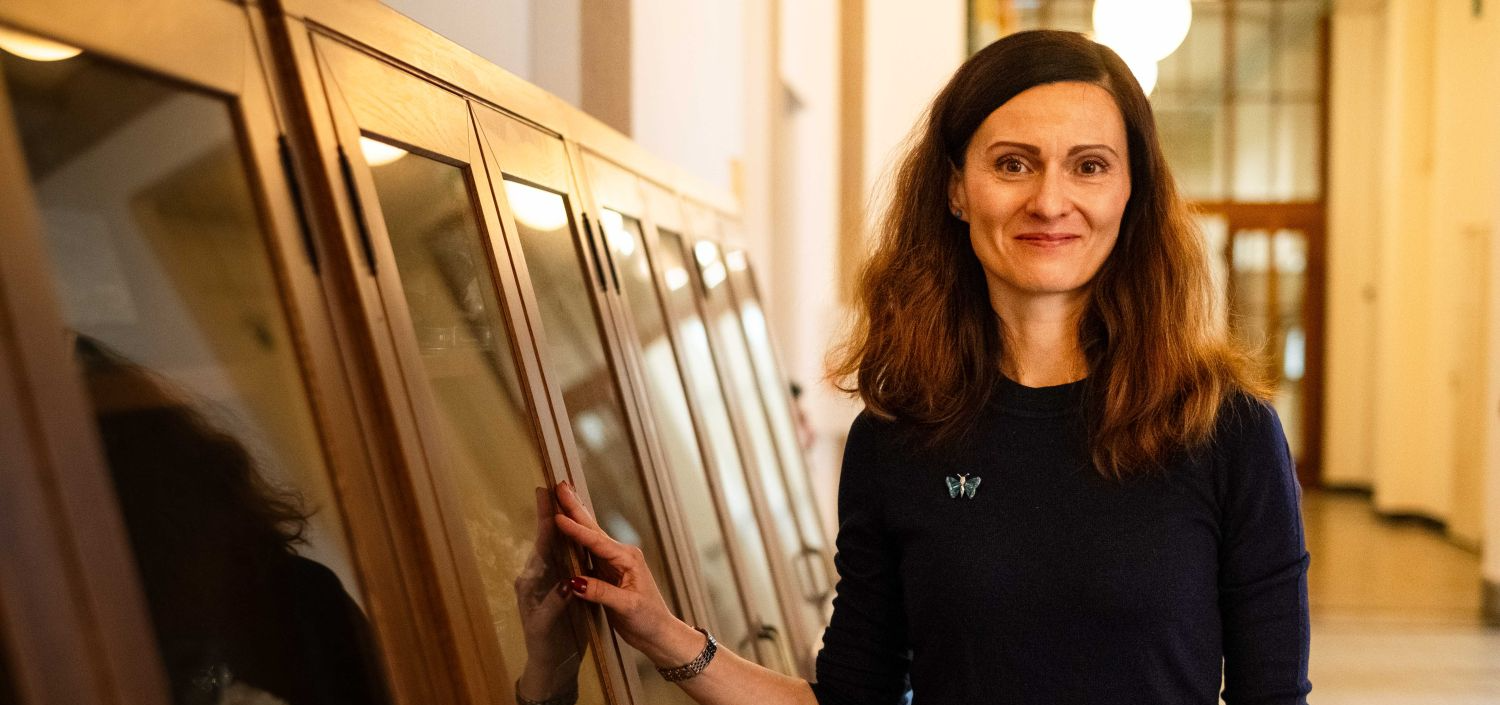
The foundation charter for the Dejvice campus is missing. As for the original foundation stone, that one…
When UCT Prague began implementing Associate Professor Sýkora’s idea for celebrating the 100th anniversary of the laying of the Dejvice Campus’ foundation stone, our first question was: actually, where is the original cornerstone? Several “reliable” stories about its fate had been circulating (including one claiming that the cornerstone had been stored in a contaminated experimental tunnel under Building A) until thorough research conducted by historian Věra Dvořáčková from UCT Prague’s Department of Education and Humanities and the Masaryk Institute and Archives of the Czech Academy of Sciences (CAS) finally shed some light upon its fate.
Why was the Dejvice campus built in the first place? And how many people was it supposed to serve?
In the 1920s, Czech Technical University in Prague (CTU), which was and still is the oldest and largest technology-oriented university in the country, had more than five thousand students. Before the Dejvice Campus was built, CTU had as many as 35 different locations across Prague, which was not ideal. Some of these spaces lacked suitable and dignified conditions for instruction.
What other universities existed in then-Czechoslovakia at that time?
If we were to talk only about engineering-oriented universities, in addition to CTU, there was Deutsche Technische Hochschule Prag (Prague German University of Technology), CTU Brno, Deutsche Technische Hochschule Brünn (the Brno German University of Technology), and the Mining University in Příbram. Beyond technology-focused fields, there were, of course, also Charles University in Prague, Masaryk University in Brno, and the Faculty of Theology in Olomouc. A little-known fact today is the existence of the Russian Free University in Prague at that time, established in 1923 for Russian students in political exile.
What did the establishment of the Dejvice Campus mean for the newly formed First Czechoslovak Republic?
The construction of a representative and modern location for Prague’s Czech Polytechnic, an incubator for the country’s scientific, technical, and industrial elite, was truly a high priority. The First Republic attached extraordinary importance to education, particularly to mass scale education and enlightenment of the Czech-speaking part of the population aimed to its prosperous development and maintaining its respected position in Europe.
What were the estimated costs of construction for the Dejvice Campus and who was supposed to have paid for it?
In 1925, they expected that the total costs would be approximately 200 million Czechoslovak crowns, with the bulk of the costs covered by the state.
How has the role of natural sciences and engineering changed over the years in the context of Czechoslovak education?
From the nineteenth century to the second half of the twentieth century, the position of engineering disciplines shifted within the academic system from a relative periphery of the scientific prestige to a very privileged status. The First Republic approach was probably the most balanced in terms of appreciation for all scientific areas and fields. A dramatic shift occurred after the end of World War II, when natural sciences and engineering were expected to provide rapid and effective assistance in ensuring the prosperous development of the national economy, decimated not only by the war but also by the “inorganic” interventions of the communist regime.
Which other locations were considered for a technology campus and why was Dejvice ultimately selected?
Vinohrady and Letná were also considered, however, Dejvice was seen as the most advantageous option at the time, mostly because the Dejvice land was cheaper.
The groundbreaking ceremony for the Dejvice Campus took place on 21 June 1925. Why was this date chosen and what symbolism does it have?
Although the date 21 June is most often remembered in Czech history as the day when 27 Czech lords were executed after the Battle of White Mountain, which one would think to be fitting for the unfortunate fate of the CTU foundation stone, this event certainly did not play any (not even symbolic) role in its laying in 1925. The date was chosen also because of the June jubilee congress of the Association of Czechoslovak Engineers and Architects, which happened to take place then. The ceremonial act of laying the foundation stone was part of this event.
As a historian, what particularly caught you attention about the ceremony?
I might mention the huge demonstrative support of the majority of the then (thousands of) CTU students who marched from the historic CTU building on Charles Square all the way to Dejvice.
There are quite a few myths surrounding dramatic fate of the original foundation stone for the Dejvice Campus. What do professional historians say about this topic?
The campus foundation stone certainly survived the World War II without external damage, although it is not certain whether the foundation charter deposited inside the stone survived. All we know for sure is that in 1953, the cornerstone was demolished with a bulldozer by workers from the Garrison Administration of Prague 6, probably due to carelessness or incompetency. According to the surviving protocol of the event, a metal box, the lock for the box, and commemorative coins from 1924-1925 were handed over to the CTU Rectorate. We have no idea if the foundation charter was still in the box at that time. In any case, not only the charter, but also all the other objects recorded in the protocol are missing.
Antonín Engel is the central figure behind the original urban design concept for the Dejvice Campus. What are the main elements of his urban design still visible today?
His main urban contribution is evident at first glance in the geometric concept of Vítězné Square and its surroundings.
Engel’s concept was also influenced by his Viennese mentor Otto Wagner. In what specific ways is this influence most visible in Dejvice?
Especially in the effort to build a modern metropolitan district in Dejvice, with residential, office, and infrastructural buildings positioned in an appropriate functional and artistic constellation. An interesting, typically “Wagnerian” element were open interior spaces (Luftzentren) instead of classic parks, as we can see on the Dejvice campus.
How did subsequent historical events influence the implementation of Engel’s original campus plan?
Of the original plan, which included ten university buildings, only two were built: today’s UCT Prague Buildings A and B. The construction of the other planned buildings was stopped by the global 1930s economic crisis and the subsequent Second World War.
How were UCT Prague’s buildings used during World War II?
After all Czech universities were closed in November 1939 following anti-Nazi student demonstrations, their movable and immovable property fell entirely into the hands of the Nazi occupation administration. The Dejvice university buildings thus served as barracks, a hospital, a warehouse, and so on for the next six years. The movable inventory was largely stolen, destroyed, or damaged.
Why did only the Klokner Institute remain operational?
The Klokner Institute (then the Research and Testing Institute of Building Materials and Structures) was part of CTU and was also closed as such in 1939. However, in 1940, its management managed to have it reopened based on the argument that it was not primarily a teaching institution but was focused rather on practical testing carried out with a unique set of instruments. Klokner Institute activities were resumed upon a requirement of cooperation with Third Reich companies, notably the Junkers Flugzeug- und Motorwerke (Junkers) aircraft and aircraft motors manufacturer, but because of this cooperation, a whole range of instructors and students who had suddenly found themselves unemployed or without the possibility of studying were professionally or academically engaged again. Many students were also able to continue finishing their Master’s, doctoral, and habilitation theses there.
What did the change in the vision for urban planning bring after 1957 and how has it influenced the development of the Dejvice Campus to this day?
Although Engel’s neoclassical style was already definitively abandoned in 1957, his very idea of building a university campus in Dejvice was never forsaken. It is somewhat paradoxical that Antonín Engel decided to design a new complex of buildings for CTU in a neoclassical style, as he considered it timeless. After World War II, however, that style already seemed outdated and, above all, unnecessarily expensive in its monumentality, sophistication, and ornamentation. Gradually, at relatively long-time intervals, the headquarters of other parts of CTU were built according to the architectural concepts at the time they were constructed. And so, prior to 1989, the “comb structure” of CTU’s Faculties of Mechanical Engineering and Electrical Engineering was created in the neo-functionalist style. The Faculty of Civil Engineering building represented brutalist architecture. In the 2000, the empty lots on campus were filled with modern buildings: the National Library of Technology and the CTU Faculties of Architecture and Information Technology.
Have the archival materials for the Dejvice Campus (as well as UCT Prague) been catalogued to date?
Most of the relevant materials are in the CTU Archive and are in an officially “unprocessed” state, although a significant part of them have at least been initially classified and provided with a provisional inventory record or a note. Some important materials can be found in the National Archives and in various state institutional (notably various ministerial) collections, with varying levels of accessibility. Antonín Engel’s files are kept in the Archives of the National Technical Museum.
Why is it important to study primary sources?
Everything that happens today has its historical roots. If we understand them, we will be better able to navigate the present. They act as a guide for us to what is good to learn from, what we can be inspired by, what is appropriate to build upon.
What other projects are you working on in your research?
At UCT Prague, I am currently working on a Ministry of Culture project, NAKI III: Technical Intelligence in the Czech Lands and Czechoslovakia 1707–1950, which is dedicated to examining how so-called “technical intelligence” emerged in the Czech Lands and Czechoslovakia in the first half of the twentieth century. The research to date already indicates that this is, in many ways, a phenomenon unique within Europe. It will be mapped both quantitatively, in the form of a public database, and thematically, in the form of a book. The project outputs should be available by the end of 2027.







